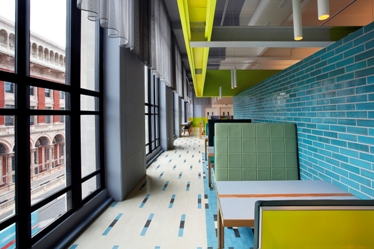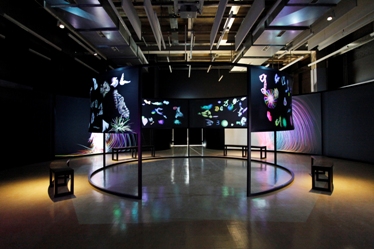After months of operating under threat of closure, the National Media Museum in Bradford is now relishing its collaboration with the Science Museum in London. The opening of the new Media Space project at the Science Museum will showcase the National Media Museum’s unique National Photography Collection. As the first of many planned exhibitions opens, this new collaboration is intended to give the collection the international platform it deserves.
Part of the Science Museum’s “Masterplan”, which lays out its vision to create dramatic new galleries, learning zones, new public spaces and visitor facilities, using the best design and technology, Media Space, opened at the end of September. It promises to bring together photographers, artists, curators and the creative industries to explore relationships between photography, science, art and technology. Whilst art collections at the Science Museum may be something unexpected, the correlation between art and science is something that Vivienne Westwood put best when she gave a speech at the museum. Ian Blatchford, Director of the Science Museum Group, quotes her as saying “the thing about great artists and great scientists is that they have great imagination – they see the world differently “. It is, he says, this blending of art and science that makes “having great artists here very valuable”.
Costing £4.5 million and 3 years in the making the design has been led by Ben Kelly Design who have worked on projects including The Hacienda in Manchester, the British Designer exhibition at the V&A and The Basement at the Science Museum. With a 525m2 major exhibition gallery, a flexible Media Studio for installations, events and creative workshops as well as a café/bar, Media Space is intended to showcase the National Photography Collection through a series of major exhibitions. Housed in the Museum’s former Printing and Printmaking gallery, BKD’s approach was to try and retain and exploit the qualities of the building, not least to retain the heroic volume of the overall space.

And heroic space it is! Media Space is now one of the biggest venues for photography in Britain. The main space has walls on wooden frames that run down the centre creating the feel of a gallery within a gallery, and increasing the wall space dramatically. Its first major exhibition, running until March 2014, is Only in England, designed by Drinkall Dean and featuring photographs by Tony Ray-Jones and Martin Parr. This collaborative effort will then head north to the National Media Museum to run until June 2014.
Museums + Heritage Advisor spoke to Emma Hedderwick, Project Leader: Media Space to gain some insight this huge and exciting project:
EH: Projects of this size and nature can have practical challenges. In order to display some of the collections, particularly some of our early photographs, we needed to create a suitable environment. We needed to consider the size of the equipment required would fit in a building of this size and age, the level of environmental control needed and the potential final cost of running the equipment.
Having an environmentally conditioned gallery was always at the core of Media Space and remained a constant factor during the planning process. We needed to balance our different requirements to ensure we got this important element right. This meant close working between consultants, curators, conservators and our Estates department to achieve an environment that satisfied the core requirements including how much flexibility was required, where the equipment would be located and final energy usage.
Media Space is a flexible temporary exhibition and event space, created to have distinct spaces within which elements can be changed. The designers have created a circulation space and café with real character while allowing the gallery and the Virgin Media Studio (the main display spaces) to be clean and simple, able to adapt to a different character for each display.
In the gallery, the walls around the perimeter hide many of the electrical, data and ducting services and are faced with Fermacell, a material to which objects, new media equipment and exhibition structures can be fixed. There is a grid of electrical and data network points in the floor and at high level on the walls. The main lighting consists of seven rows of lighting track spaced evenly across the ceiling that ensure that all areas of the gallery can be lit, including the addition of any new structures in the future.
A number of luminaires were selected by our light consultant and tested in the gallery before a final product was selected. Considerations included which lights were best suited for photographs, whether they were dimmable, energy usage and the types of lights available from the chosen manufacturer. The final choice was supplied by Light Projects.
The Virgin Media Studio also has walls lined with Fermacell and a grid of electrical and network points across the floor. As this space also has to host events and conferences, the main lighting is an array of fluorescent lights that provides general but flexible lighting. Above this there is also a structural grid capable of supporting a hanging track, lighting, projectors and objects. The Studio also has the capability of hosting conferences and is equipped with a permanent projector and surround sound system.
The inaugural installation in the Virgin Media Studio is by digital artist studio collaborators Universal Everything. Called Universal Everything & You it is a forward-looking digital installation that harnesses technology to create both a living sculpture for viewers to immerse themselves in and an interactive element that allows the visitor to create part of the art by using a smart phone app.

EH: When we started planning to work together, Matt Pyke, Creative Director of Universal Everything was really excited about our ambition to do projects that work closely with our audiences. Audience engagement is something the Science Museum has a long history of doing. He loved the idea of extending his own collaborative process and notions of interactivity to the point where the work really wouldn’t exist at all without the involvement of the visitors.
Media Space is a collaborative project between National Media Museum and the Science Museum. The Head of Media Space, Hannah Redler, manages a mixed team across both institutions that includes curators, researchers, producers and co-ordinators. Our plan is that a large proportion of our exhibitions will be developed from our archive.
But Media Space is not about simple ‘show and tell’. It is about curating exhibitions that contextualize the National Photography Collection in contemporary concerns both within photography and wider arts and cultural contexts. Some exhibitions like our launch exhibition “Only in England” are made up almost entirely of objects from the collection whilst others, for example our second major exhibition which will be “Revelations: Experiments in photography”, draw on objects in the collection as the starting point but broaden out to include international loans from other institutions and practicing artists. It’s about making collections relevant and contemporary and contributing to and leading on new ideas.
With more photographic images taken in the past 12 months than in the entire history of photography, no doubt there is a goldmine of photographic histories in the making.
Key Contractors:
- Lead Designers – Ben Kelly Design
- Graphic Production – Graphic Thought Facility
- Contract Catering – Benugo





